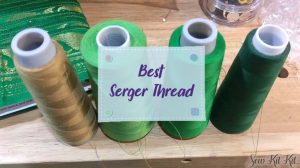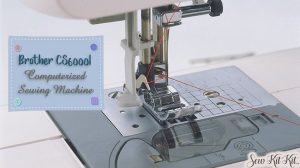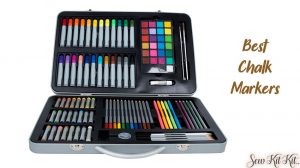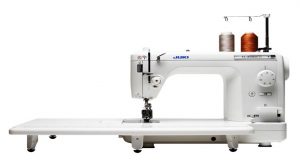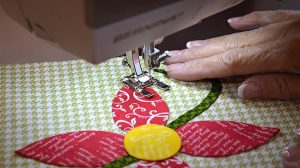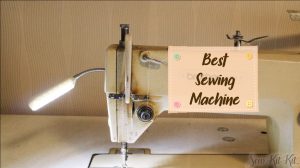Last Updated on January 10, 2023
Are you a beginner looking for a guide to buying a sewing machine? Don’t know what you want and what to look for in a sewing machine? Join us as we go through a full guide to buying the best sewing machine for beginners. Learn what you need and what you don’t here.
When you buy through links on our site, we may earn an affiliate commission. As an Amazon Associate I earn from qualifying purchases.
The sewing machine is a powerful machine to help you through your tedious sewing works. It helps you get crafty and creative with your fabric. But as a beginner, you might it a little tough to find a good sewing machine. You might not be sure what you want or need. You might not even know your budget. Our job is to help you thought about it.
To ensure you get the best sewing machine for beginners you have to know a few things about the sewing machines and the things they have to offer. Here is a simple discussion on all the things necessary for you to find the best one on the market.
By now you already know what type of sewing machine you want and what to look for in a sewing machine. We have gone through a lot of different products and are going to suggest to you a few of the best beginner sewing machines. You can buy one of the suggestions or one of your own choices. But going through these will certainly make you understand which sewing machine you actually want.
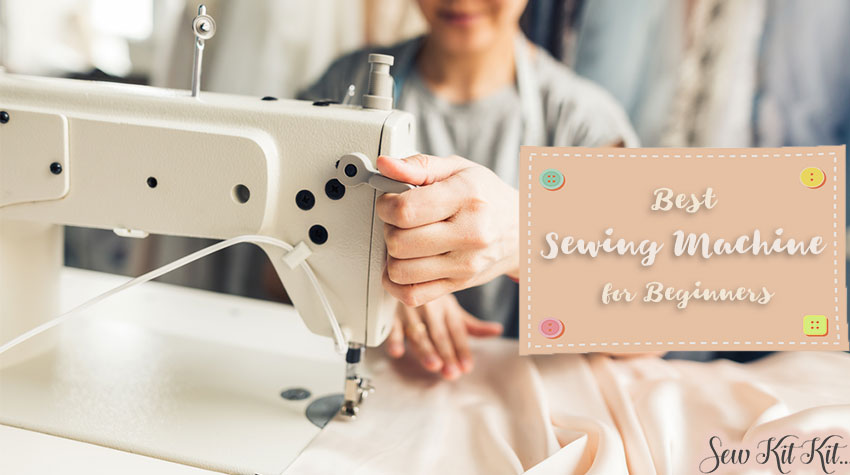
The 7 Best sewing machines for beginners
| Image | Title | Buy |
|---|---|---|
 Top
Top | Janome MOD-19 Easy-to-Use Sewing Machine with 19 Stitches, Automatic Needle Threader and 5-Piece Feed Dogs | Check Price! |
 Top
Top | SINGER 4423 Sewing Machine, grey | Check Price! |
 Top
Top | Janome HD1000 Mechanical Sewing Machine w/ FREE BONUS Package! by Janome | Check Price! |
 Top
Top | Brother XM2701 Sewing Machine, Lightweight, Full Featured, 27 Stitches, 6 Included Feet | Check Price! |
 Top
Top | SINGER Start 1304 6 Built-in Stitches, Free Arm Best Sewing Machine for Beginners, 11.46 pounds | Check Price! |
 Top
Top | SINGER 7258 100-Stitch Computerized 76 Decorative Stitches, Automatic Needle Threader and Bonus Accessories, Packed with Features and Easy Sewing Machine, 19 pounds | Check Price! |
1. Janome MOD-19
- Janome Easy-to-Use Basic Sewing Machine with 19 Stitches including 1 Four-Step Buttonhole
- Easy Threading with Built-In Needle Threader
- Top Loading Bobbin with Clear Cover and 5-Piece Feed Dog System
- Adjustable Stitch Length and Width and 4 Presser Feet
- Free Arm, Drop Feed, 25-Year Limited Warranty
This one is one of the top computerized sewing machines out there. It has 19 built-in stitches including a buttonhole stitch making it a versatile vehicle for all your sewing needs. It comes with stitch adjusters meaning you can choose the length and width of the stitch. With drop feed technology, you can run your fabric smoothly no matter the type of fabric.
It has a top-loading system with a clear cover making it easy for you to see what you are doing. Not just that, it has a needle threader too along with its many other features including 5 piece dog feed system, auto declutch bobbin winder, LED, full rotary hook, and most importantly it comes with a 25 years warranty! All things considered, this is definitely one of the best beginner sewing machines.
2. Singer 4423
- SINGER HEAVY DUTY SEWING MACHINE: The 23 built-in stitches including basic, stretch, decorative, and buttonhole stitches allow you to sew a variety of projects, such as fashions, home décor, quilts, crafts, and more
- AUTOMATIC NEEDLE THREADER SEWING MACHINE: After following the threading path printed right on the machine, this built-in feature helps you to effortlessly thread the eye of the needle without eye strain or frustration. Amps (0.7). Watts (84). Volts (120). Hz (60)
- HIGH-SPEED SEWING MACHINE:The Singer 4423 Sewing Machine has a maximum sewing speed of 1, 100 stitches-per-minute, so projects can be sewn quickly. The 60% Stronger Motor provides greater piercing power for thick seams
- HEAVY DUTY METAL FRAME: The Singer 4423 heavy duty sewing machine is a true workhorse. With a heavy-duty metal interior frame, stainless steel bedframe, extra-high sewing speed and powerful motor, this sewing machine can sew through a variety of heavy weight fabrics and provides long lasting stability
- SEWING MACHINE ACCESSORIES: A variety of accessories are included with All-purpose foot, zipper foot, buttonhole foot, button sewing foot, seam ripper/lint brush, quilting guide, needles, bobbins, screwdriver, auxiliary spool pin, spool pin felt are all conveniently located and stored in the accessory tray. A soft-sided dust cover is also included in the packaging
- WARRANTY: SINGER 4423 Heavy Duty Portable Sewing Machine has 25 Year Limited Warranty. Note : Refer to the Videos and also the PDF attached below in Technical Specification for Manua
Do you need a heavy-duty sewing machine? Or a machine that saves you a ton of time? Then Singer 4423 is just the machine for you. The singer has been the oldest company to build sewing machines. From lightweight to heavy-duty you name it, it has never disappointed.
So, naturally, this heavy-duty model has lived up to the expectation. It can do about 1100 stitches per minute and can work with heavy-duty products like denim to a canvas. Adjustable presser foot allows you to change the pressure between a single layer and multiple layers of fabric.
Although if you think all these heavy-duty features make it any less portable you are absolutely wrong! With its less than 15lbs weight, it is as portable as the rest of them. Moreover, it has 23 built-in stitches including a buttonhole. It also comes with an automatic needle threader, top-loading bobbin, adjustable stitch length, and whatnot.
3. Janome HD1000
- 14 Built-In Stitches including Utility Stitches, Stretch Stitches and a Simple to Use 4 Step Buttonhole | The Janome HD1000 Even Has a Built-In Automatic Needle Threader - Thread Your Needle with Ease and Without Eye-Strain
- The Janome HD1000s Body is Made of Cast Aluminum and Like the Metal Machines of Years Ago the Janome HD1000 is Made To Last
- Comes with A Bunch of Different Accessories Including - Bobbins, Felt, Extra Needles, Two Screwdrivers, Seam Ripper/Buttonhole Ripper, Zipper Foot, Hemmer Foot, Buttonhole Foot, a Hem Guide and a Soft Cover
- The HD1000 Has A Free Arm For Sewing Pants, Cuffs and Collars and Drop Feed for Darning, Stippling, Attaching Buttons and Other Free Motion Applications
- Bonus Package Includes: Janome Ultra Glide Foot, 10 Bobbins, Schmetz 80/12 Universal Needles (5pk), Klasse 90/14 Needles for leather (5pk). *Items may be substituted and are subject to stock on hand. Packaging might v
Janome HD 1000 is one of Janomes pricy models. But it makes that up in its performance. It has 14 most practical built-in stitches including one four-step buttonhole. It has a built-in needle threader. It has a 3 piece feed dog system for smooth feed for any fabric type. It’s very good for beginners as it has the most basic stitches.
Moreover, it’s easy to use, simple, and to be honest resembles the old machines with fewer complications. It is heavy-duty and can handle any type of fabric. Its heavy-duty aluminum body makes it long-lasting while the model has a 25-year warranty. It makes a perfectly reliable machine for beginners.
4. Brother CS6000I
- 60 Unique built-in stitches: The Brother CS6000i includes 60 built-in sewing stitches, including decorative stitches and 7 styles of auto-size buttonholes
- Automatic needle threader and drop-in top bobbin: This sewing and quilting machine includes an automatic needle threader that perfectly pushes the thread through the needle and a convenient, jam resistant drop-in top bobbin
- Included accessories: The CS6000i includes a hard protective case, wide table, 10 sewing feet, needle set including twin needle, 3 bobbins and more
- LCD Screen: Easily select your stitches with the touch of a button and view your selections on the LCD display
- 25 Year limited warranty: The CS6000i is backed by a 25 year limited warranty with free technical support for the life of the prod
If you need a lightweight machine that can be used in several different projects but doesn’t have much budget, this is the one for you. Brother cs6000i has 60 built-in stitches including basic, decorative, quilting, and 7 buttonholes styles. It comes with an LCD to select your stitch. It has a stitch length and width adjuster and even a speed selector.
Easy threading system, automatic needle threader, easy bobbin winder makes it the simplest machine to use. Dual LED lights up your workplace like no other. For your larger projects, there is even a detachable oversized table. It is lightweight so you can carry it anywhere you like. All things considered, brother cs6000i is definitely one of the best sewing machines to have.
5. Brother XM2701
- 27 Unique built-in stitches: The XM2701 includes 27 built-in stitches including decorative, blind hem, zigzag, and stretch stitches and an auto-size buttonhole
- Automatic needle threader and drop-in top bobbin: This sewing machine includes an automatic needle threader that perfectly pushes the thread through the needle and a convenient, jam resistant drop-in top bobbin
- Included accessories: The XM2701 comes with 6 sewing feet, 3-piece needle set, twin needle, 4 bobbins, instructional DVD, manual and more
- Versatile free arm: This free arm sewing machine is perfect for a wide range of everyday sewing projects, and users from beginners to advanced
- At your side support: The XM2701 sewing machine comes with Brother At your side support offering free technical support via online, live chat or phone for the life of your mach
This machine is one of the ideal sewing machines for beginners. It has 27 built-in stitches from the most basic to decorative and quilting ones, including a one-step buttonhole. It comes at a very affordable price. It has 6 sewing feet for different sewing needs. Jam resistant top drop-in bobbin, automatic needle threader, built-in free arm are just some of the many features the machine has to offer.
It is lightweight making it very suitable for taking to class. Or move around. Although it is not suitable for heavy-duty works, it certainly is a great sewing machine even for professional sewists who prefer the simplicity of the functions. It was made while keeping the beginners in mind. It can be a handy tool to keep around at a reasonable price.
6. Singer 1304
- BEST SEWING MACHINE: The SINGER Start 1304 sewing machine is basic, simple, and easy-to-use thanks to 57 Stitch Applications, all with pre-set stitch width and stitch length. Just select your stitch and start sewing
- : SINGER Start 1304 Start Free Arm Model Sewing Machine has 25 Year Limited
- LIGHTWEIGHT AND PORTABLE: This lightweight and portable machine weighs only 7 pounds, making it great for sewing in smaller spaces or taking to sewing class
- AUTOMATIC BOBBIN WINDING SEWING MACHINE: To wind a bobbin, simply follow the numbered diagram printed on top of the sewing machine. The bobbin will automatically stop turning when its completely filled
- SINGER Start 1304 ACCESSORIES: Includes All-Purpose Foot, Zipper Foot, Buttonhole Foot, Darning Plate, Pack of Needles, Bobbins, Needle Plate Screwdriver, Spool Pin Felts, Seam Ripper / Lint Brush, Power Line Cord, Foot Control, Quick Start Guide, Instruction Manual. Amps: 0. 6
- This sewing machine is warranted for use in the US and Canada at 110 volts only
- 110V Mach
Singer 1304 is a simple elegant machine with 6 built-in stitches including one four-step buttonhole. Its heavy-duty internal body frame makes it very sturdy and suitable for heavyweight fabric. It is suitable for both beginners and moderate users. It has quick and easy threading, choice from 6 stitches with just a turn of the dial.
What more is it comes with a dual spool pin for two rows of parallel stitching for your decorative needs. It comes with a 25-year warranty which makes it a great investment. Although the machine does not have too many features that you might find a lot in modern-day machines, it is definitely easy to set and simple to use making it very suitable for beginners. And the price is quite affordable.
7. Singer 7258
- PUSH BUTTON STITCH SELECTION: The SINGER Stylist 7258 sewing machine allows you to select the desired stitch with just a simple push of a button. Optimum settings for length, width and tension are set automatically and are customizable with adjustable stitch length and stitch width. Volts : 120V. Amps : 0.62. Watts-74
- WARRANTY: SINGER Stylist 7258 Sewing Machine has 25 Year Limited Warranty , 60 Hertz
- This sewing machine is warranted for use in the US and Canada at 110 volts o
This is an advanced sewing machine for both beginners and professionals. It offers 100 different stitches To choose from. From basic fashion to home décor, from quilting to appliquéing it does it all. It has 6 built-in buttonhole styles. The top drop-in bobbin is easy to see and wind. It has stitch selectors for choosing your style and speed with the push of a button.
It comes with automatic stitch width and length so beginners do not have to worry about choosing the optimum value, the machine does that for you. It is reasonably priced and offers so much more if you are just starting up. This fully computerized machine with an efficient pension system will have a speed of 750 stitches per minute and you can adjust it too.
What Type of Sewing Machine Is Best for Beginners?
As a beginner, you might be thinking of buying the latest sewing machine with the most features. There are these electrical sewing machines that have lots of different switches and knobs and can perform hundreds of different things. They are also semi-manual, meaning there are some things you have to by yourself.
And then there are the mechanical machines with a few knobs and dials, where you have to do everything manually. There are also electrically powered ones
The computerized ones have a screen where you can choose the stitch you want, sometimes even multiple stitches together. Some advanced computerized sewing machines have internet connections and they can print designs online. They are way more complicated for domestic uses and mainly used industrially.
Now, which one is the best beginner sewing machine for? Computerized, mechanical, or electrical? Let’s discuss a few things first.
Why are you buying?
From my experience I can tell you, you don’t need ALL the features if you are just starting. Make sure you know why you are buying your sewing machine. Is it just for a little mending? Or is it for heavy-duty sewing? What kind of stitches will you need to do? So, when you buy a sewing machine make sure it is capable of doing just THAT, other features are just irrelevant. If you are thinking of working with heavy-duty fabric make sure your sewing machine weights it. Otherwise, it won’t be able to stitch effortlessly.
Can it do the basic stitches?
The more complicated machines you buy the more it will be harder for you to handle. Today’s sewing machines basically do everything for you. But if they are not capable of sewing the basic stitches they are practically useless. You must know, most of the added features are for intermediate users. So as a beginner, try the sewing machine that can do the basic stitches including straight stitch, zigzag stitch, etc effortlessly.
How’s your coordination?
If your coordination is not good enough and you cannot manage to maintain foot pedaling and moving fabric at the same time, if it is difficult for you to stop at the exact moment you want to stop, you could try the electrically powered machines. This way you won’t have to concentrate on both your foot and your hand holding the fabric at the same time. There is a button for starting and stopping your sewing, you can use it to stop sewing whenever you like.
How’s your budget?
Now the cost is an important factor in buying sewing machines whether you are a beginner or a pro. The complicated machines cost way more than the mechanical ones. If you are thinking to buy a cheap one because “you won’t be doing a lot of sewing” or “what if you don’t like sewing” I suggest you don’t. Because a cheap machine can become responsible for the “reasons” you bought a cheap one in the first place.
They will not give out straight stitches, miss a few stitches, get jammed easily, and will not last long. So, go for the reasonably priced ones if you are thinking of saving a few bucks. Then if you think of continuing, invest in buying a more expensive one. Trust me it will be worth it. It will last you ages and won’t need much repairing.
In short,
Set your priorities straight; don’t be dazzled with the buttons and dials. Just stick with the basics and once you master the art of sewing go for the advanced ones. Buy the electrical ones to save you some physical effort. But don’t start with the computerized ones.
That is not for you especially since you are a beginner and it won’t help you learn anything. If you want to start with the very basics start with a mechanical one, the one your grandma would use. This way you will learn a lot about how a sewing machine works in general. But if you don’t, a few easy features have never hurt anyone as long as they fulfill your priorities.
How to Find the Best Sewing Machine for Beginners
After you have decided on what kind of machine you are going to buy, let’s talk about what you should look for in your machine. However, your choice may vary with the kind of work you want to do. But we are going to explain this strictly from a beginner’s perspective who wants to stick with the domestic uses.
Before we start, you must know that you should buy your products from a known source as well as a well-known brand. This will help you avoid getting cheap knockoffs and wasting your money. With that in mind, we are going to classify your needs into three categories: The essentials, The additional, and The optional. This will help you choose your machine based on your needs.
The essentials
Three things are must-haves in your machine. These are weight, straight stitch and speed, and strength.
Weight
A good machine weights it. The lightweight ones are usually not very sturdy. But some brands make lightweight machines for making them portable. If you are thinking of traveling with your machine make sure you buy a recommended one after consulting with someone who has already bought one of those. But for domestic sewing try buying one that has a good weight to it. It will be especially helpful with heavy-duty sewing.
Straight stitch
Your machine could do a thousand stitches but if it can’t do a straight stitch it’s no good. The straight stitch is the most basic. A good straight stitch would mean the machine can do any stitch well. The straight stitch is the most used and if you can try out your machine before buying. If it can do a good straight stitch without missing any stitch then you are good to go.
Speed and strength
A good machine has decent speed. Now as a beginner you don’t need too much speed. If you don’t know how much control you have to buy a machine that has a speed control dial. If not, then try out your machine to see if you are comfortable with the speed.
The additional
There are a few additional things you might consider before buying a sewing machine. We used the term additional because these are not necessary. But this will certainly give you some extra benefits.
Buttonhole stitch and zigzag stitch
There is actually a completely separate set of machines for sewing button whole. But in modern sewing machines, include this feature as well as a zigzag stitch. As a beginner, you don’t absolutely need this. But this will certainly lessen some effort.
Full rotary hook
There are two types of shuttle specifications: full rotary hooks and oscillating hooks. Full rotary hooks are where the bobbin completes a full circular path while stitching. Oscillating hooks go back and forth instead. Machines with full rotary hooks run very smoothly even at high speed. They make very little or no noise at all and are much less prone to jamming. Although they could be a bit expensive.
Universal pressure
This is an added feature in many modern-day sewing machines. It means you can change the layer to multiple layers without having to change the settings. This way you can work more freely.
The optional
The optional features are the ones that will give you a little bit more comfort and ease. You will not get them in all sewing machines, but the latest models tend to have these.
Needle threader
This is a new feature and most electrical machines these days have one. This is a tiny lever that helps you thread your needle. If you have poor eyesight, this feature will come in very handy.
Tri motion stretch
This stitch means the needle goes forward, backward, and sideways. Not only it hems the edge of the fabric but also seals the edge. This gives you a nice designed and secured edge.
Bigger opening
The bigger opening means the arms are much wider leaving you more space to work with. Some machines come with a removable front part which gives you a larger opening at your will. This feature helps you place your hands-free without having to get in the way.
These are the things you should consider before buying. If you have some more preferences you could always look for them. Make sure you talk to your dealer about the things you want in your machine before buying. Ask about the warranty policy, it should be at least 20 to 25 years. Keep these in mind and you will be just fine.
Sewing Machine Basics
Sewing machines these days are very complex with so many different functions; some we need some we don’t. Formerly chain stitching used to be used in the sewing machine, but now most of the machines are lock stitching machines. Anyways, if you are just starting sewing with a machine, it must feel like a puzzle to you. But a sewing machine, whether it’s a mechanical one or an electrical one, has a few basic parts. Here we will discuss the basic parts of a sewing machine very shortly and help you understand their function.
1. Power switch
I started with this because it is only seen in electrical machines. It turns on the machine. You can usually find it on the right side of the machine.
2. Spool Pin
It is a thin metallic rod seated on the top of the machine body. It is used for holding the thread spool.
3. Handwheel
It is also known as the flywheel. It helps you lower down or pull up the needle. In the hand-driven machines, there is a lever attached to it to drive the machine.
4. Bobbin
The bobbin is a small spool for holding the thread. This goes under the machine where it provides the thread for the stitches from underneath. You will need to wind it before stitching. Most machines have a bobbin winder for that.
5. Bobbin case
The bobbin goes inside a bobbin case. There is a metal latch attached to it and a release lever to pull the bobbin case out of the machine. There is also a hook on the case. The hook catches the thread from the needle and loops it with the thread coming from the bobbin.
6. Bobbin Winder
As it was said earlier, there is a bobbin winder for the winding thread in the bobbin. This looks like the spool pin. In most machines, there is a knob for stopping bobbin winding.
7. Thread guide
In sewing machines, there are arrows to show which way your thread should go before going through the needle. The thread guide maintains the tension on your thread for sewing.
8. Take up lever
The thread goes through the take-up lever and into the needle. The take-up lever feeds the thread to the needle and keeps up the tension while sewing. It plays a very important part in sewing.
9. Presser’s foot
This small paddle-shaped thing is seen under the needle. It holds the fabric in its place while sewing.
10. Presser foot lifter
A Presser foot lifter is a lever that pulls up the presser foot for releasing the fabric from underneath. It helps pull up and pull down the presser foot. It is usually at the back of the machine.
11. Needle
The needle is the most important part of a sewing machine. It usually hangs from a needle bar and clamped to it with a screw. You can change the needle if you like. There is a different sized needle for different weighted fabrics. It has an eye through which the thread is passed.
12. Feed dog
The feed dogs are situated below the needle and have a set of teeth. They move the fabric along after every stitch.
13. Slide plate
This is a rectangular-shaped plate under the presser foot that you have to slide away while pulling out the bobbin.
14. Dials
There are different types of dials seen in sewing machines. They control different stitching actions. Stitch length dial, speed control dial, stitch width selector and pattern selectors are the most common dials. Some machines have all of them; some have two or three of them depending on the model.
15. Foot pedal
The foot-driven machines have a pedal attached to them. You have to move it up and down to drive the machine.
We talked in detail about different sewing terms that will help a lot, especially for beginners.
Common Mistakes Made by the Beginners While Choosing Sewing Machine
As a beginner, you might face some problems choosing the right machine. If the research is not done properly or if you are not guided enough you might end up making a few mistakes most beginners do. The most common mistakes done by beginners are:
1. Buying fancy machines
When you are just starting out you might realize there are a thousand different models to choose from. It is quite easy to be distracted by the bells and whistles of modern computerized machines with so many features. That is where the mistakes begin. What you need to keep in mind that you don’t need so many different features. The basic stitches are what you need as a beginner.
Why buy machines with a hundred different if you are not going to use most of them? And what is the point of buying a fancy machine if cannot even do the basic stitches properly? Besides, these features don’t come cheap. You have to pay the extra money for something you won’t be using at all. So basically it will just be a waste of money. After you become a moderate sewist you can look into some additional features.
2. Buying an expensive one
Now you might think buying an expensive machine will give you some extra benefits. But that is where you are wrong. Money does not bring you much-added value. Pricy machines do come with a few extra features, but most of them won’t come to any use if you are just a beginner. But that does not mean you should buy the cheapest ones available or even a very old one.
Nowadays even the best brands have a few models that are made by keeping the beginners in mind and these are not expensive at all. Even the computerized models do not cost too much. A reasonably priced machine with a good warranty period is what you need. A few extra features would come in handy too if it is affordable.
3. Buying a cheap one
You might think that since you are not going to be doing a lot of sewing, you might as well buy from a grocery store or whatever the kind of store that sells everything. But keep in mind that it would not do you any good. Those sewing machines will give you nightmares in sewing.
They will not sew, they will skip stitches, the needles will break, and everything possible to go wrong, they will and most probably within a year or so. Buying from a known dealer and a sewing store will give you a lot of extra benefits. You can take any of the problems you might be facing to them and they will fix them for you. Some of them even offer free classes.
4. Buying a heavy-duty sewing machine
Most of the beginners think that they would buy a machine that can serve all of their purposes. This is why they tend to buy heavy-duty ones as they can work with any type of fabric. What happens is, the heavy-duty ones are in fact very heavy. They end up carrying dead weight for no reason.
As a beginner, you won’t have many heavy-duty works and you need a portable machine to take to class. So, don’t buy heavy-duty machines and try the lightweight ones. Although some of the heavy-duty machines these days are very lightweight.
5. Buying without consulting
Depending on your dealer is a good thing if you know him/her. But only depending on their opinion most probably won’t get you the best machine. When you don’t do your research on what you need you will end up with a useless sewing machine.
Another mistake that beginners tend to make is not communicating enough with the dealers and let the dealer decide what they need. Actually, it’s the other way around. Let your dealer know what you want and learn their policy to avoid any further inconvenience
These are the most common mistakes you could make. And now, you won’t anymore.
How to Use a Sewing Machine Safely
Sewing machines are handy tools and powerful machines and working with them needs extra precautions. It’s not just you who needs care, your machine needs to.
1. Unplug your machine after use
It might seem a drag but you should unplug your machine after every use. It will keep your machine safe from any unexpected electrical malfunction. Don’t yank the chord of the socket, do it gently.
2. Keep your fingers safe
While sewing near the needle make sure your fingers are away from the needle. You can use a finger guard for extra precautions. Most people choose not to wear them. But it is better safe than sorry.
3. Service the machine twice a year
It helps you avoid any unwanted risks and makes sure your machine is in top condition.
4. Ensure enough lighting
Make sure your workspace is enough lit. Otherwise, you might end up sewing through your fingers. Most sewing machines these days offer LED light over your sewing place. It helps you see what you doing better as well as prevents any accidents.
5. Change needles for different types of fabric
Make sure you use the appropriate needle for appropriate works. Otherwise, you might end up breaking the needle or even damaging the machine altogether. Most machines provide a needle of different kinds. Use them accordingly.
6. Don’t sew over pins
You can use pins as your guideline but make sure you keep a distance while sewing near them. If your needle goes over these pins,it will break it and fling it somewhere, and cause serious safety issues.
7. Pay attention to your machine
Take care of your machine regularly. Don’t use fabrics that the machine is not equipped for. If the machine makes any unusual noises take it to a professional. If it starts to skip stitches do the same. Oil your machine (if mechanical) regularly. But make sure any extra oil is not left anywhere to be slipped on.
8. Keep away from any distractions
Be mindful of what you are doing. Tie up your hair if possible, otherwise, your hair might get caught up in the machine and you will end up with a nasty injury.
If you take care of your machine it will last a long period of time. Keep it well maintained and you won’t have to buy another one for generations. But don’t forget about your own safety either.
Sewing Machine FAQ
Here are a few questions asked by folks about sewing machine:
Can a sewing machine needle be sharpened?
Yes, you can do it yourself by sewing over fine-grit sandpaper or if you wish to get it done professionally.
Can a sewing machine sew leather?
Yes, heavy-duty sewing machines can sew leather. But you have to use the appropriate needle for the job. A domestic machine can sew through garment weight leather.
How do I lift the presser foot up and down?
There is a presser foot lifter at the back of the machine. This lever is used for lifting the foot up and down.
Which way should I turn the handwheel?
The handwheel is used for raising or lowering the needle. It should always be turned towards you in a clockwise motion.
What is sewing machine oil?
Sewing machine oil is the oil used in the sewing machine parts for reducing friction and improve the performance of the machine.
Why does my machine skip stitches?
You probably have a blunt needle or your machine does not have enough foot pressure or the needle might have been inserted incorrectly.
Why does my fabric pucker?
It is maybe due to your fabric type; it probably is too soft. Or your upper thread tension or bobbin thread tension is too tight.
Why do I keep breaking my needles?
You are probably pulling your fabric while sewing. Or you might be using the wrong needle for fabric. A lightweight needle cannot be used in heavy-duty fabric
What is sewing machine timing?
Sewing machine timing is synchronizing different parts of your machines for getting even stitches.
Does it always mean a beginner’s sewing machine is cheap always?
No such rules there, but the basic sewing machines are cheap always.
Conclusion
Buying a sewing machine is not an easy task. Especially if you are a beginner. It is always better to look for recommendations. Buy it from a recognized or well-known dealer and brand. If you know someone who has been using a sewing machine and has been satisfied with the performance buy that. Of course, before buying talk to your dealer, learn about all the things it has to offer, compare a few models, and if possible try out a few. The best sewing machine for beginners doesn’t have lots of different features but is efficient and offers brilliant performance in what it does. As we discussed above, use our guide to choose what you need. Be very sure before buying. Because, a sewing machine is not just a handy tool, for now, it is an investment.
References:

